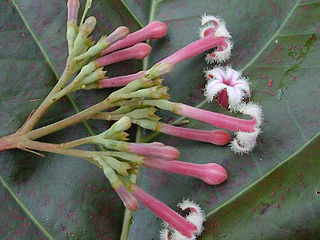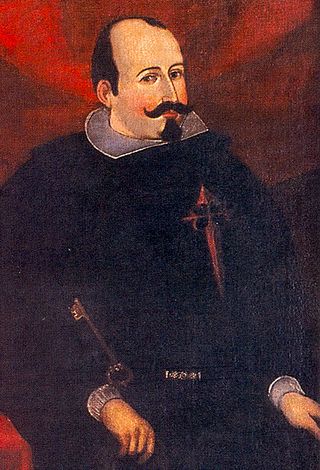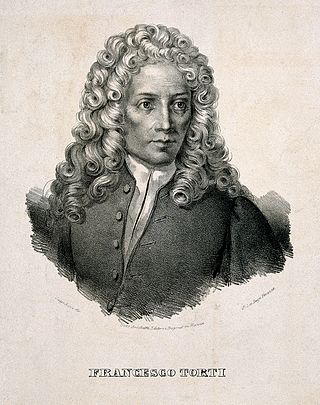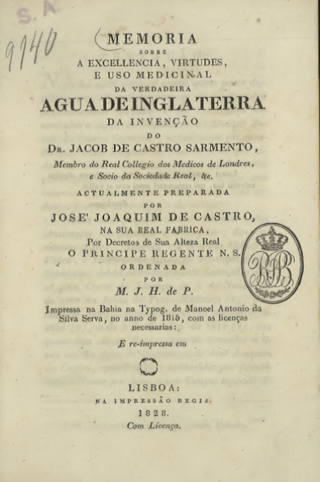Related Research Articles

Quinine is a medication used to treat malaria and babesiosis. This includes the treatment of malaria due to Plasmodium falciparum that is resistant to chloroquine when artesunate is not available. While sometimes used for nocturnal leg cramps, quinine is not recommended for this purpose due to the risk of serious side effects. It can be taken by mouth or intravenously. Malaria resistance to quinine occurs in certain areas of the world. Quinine is also used as an ingredient in tonic water to impart a bitter taste.

Gentianales is an order of flowering plant, included within the asterid clade of eudicots. It comprises more than 20,000 species in about 1,200 genera in 5 families. More than 80% of the species in this order belong to the family Rubiaceae.

Cinchona is a genus of flowering plants in the family Rubiaceae containing at least 23 species of trees and shrubs. All are native to the tropical Andean forests of western South America. A few species are reportedly naturalized in Central America, Jamaica, French Polynesia, Sulawesi, Saint Helena in the South Atlantic, and São Tomé and Príncipe off the coast of tropical Africa, and others have been cultivated in India and Java, where they have formed hybrids.

Tonic water is a carbonated soft drink in which quinine is dissolved. Originally used as a prophylactic against malaria, nowadays tonic water usually has a significantly lower quinine content and is often sweetened. It is consumed for its distinctive bitter flavor and is frequently used in mixed drinks, particularly in gin and tonic.

Christian Friedrich Samuel Hahnemann was a German physician, best known for creating the pseudoscientific system of alternative medicine called homeopathy.

A bitters is traditionally an alcoholic preparation flavored with botanical matter for a bitter or bittersweet flavor. Originally, numerous longstanding brands of bitters were developed as patent medicines, but now are sold as digestifs, sometimes with herbal properties, and as cocktail flavorings.

Medicinal plants, also called medicinal herbs, have been discovered and used in traditional medicine practices since prehistoric times. Plants synthesize hundreds of chemical compounds for various functions, including defense and protection against insects, fungi, diseases, and herbivorous mammals.

Bernardino Ramazzini was an Italian physician.

Jesuit's bark, also known as cinchona bark, Peruvian bark or China bark, is a former remedy for malaria, as the bark contains quinine used to treat the disease. The bark of several species of the genus Cinchona, family Rubiaceae indigenous to the western Andes of South America, was introduced to Jesuit missionaries as a traditional treatment for malaria by indigenous people in Peru during the 17th century.

Luis Jerónimo Fernández de Cabrera Bobadilla Cerda y Mendoza, 4th Count of Chinchón, also known as Luis Xerónimo Fernandes de Cabrera Bobadilla y Mendoza, was a Spanish nobleman, Comendador of Criptana, Alcaide of the Alcázar de Segovia, Treasurer of Aragón, and captain general and Viceroy of Peru, from January 14, 1629, to December 18, 1639. His wife, Ana de Osorio (1599–1625), is credited as being one of the first Europeans to be treated with quinine, and as the person who introduced that medicine into Europe.

Cinchona officinalis is a South American tree in the family Rubiaceae. It is native to wet montane forests in Colombia, Ecuador, Peru and Bolivia, between 1600–2700 meters above sea level.

Cinchona pubescens, also known as red cinchona and quina (Kina), is native to Central and South America. It is known as a medicinal plant for its bark's high quinine content- and has similar uses to C. officinalis in the production of quinine, most famously used for treatment of malaria.

The history of malaria extends from its prehistoric origin as a zoonotic disease in the primates of Africa through to the 21st century. A widespread and potentially lethal human infectious disease, at its peak malaria infested every continent except Antarctica. Its prevention and treatment have been targeted in science and medicine for hundreds of years. Since the discovery of the Plasmodium parasites which cause it, research attention has focused on their biology as well as that of the mosquitoes which transmit the parasites.
A medicinal jar, drug jar, or apothecary jar is a jar used to contain medicines. Ceramic medicinal jars originated in the Islamic world and were brought to Europe where the production of jars flourished from the Middle Ages onward. Potteries were established throughout Europe and many were commissioned to produce jars for pharmacies and monasteries. They are an important category of the Dutch and English porcelain known as Delftware.

Traditional African medicine is a range of traditional medicine disciplines involving indigenous herbalism and African spirituality, typically including diviners, midwives, and herbalists. Practitioners of traditional African medicine claim, largely without evidence, to be able to cure a variety of diverse conditions including cancer, psychiatric disorders, high blood pressure, cholera, most venereal diseases, epilepsy, asthma, eczema, fever, anxiety, depression, benign prostatic hyperplasia, urinary tract infections, gout, and healing of wounds and burns and Ebola.
The Schedula Romana was a pharmaceutical handbill published in 1649. Generally assumed to have been designed after the knowledge of the cinchona bark properties brought from South America by Spanish Jesuit Juan de Lugo, the Schedula Romana is considered to be an early example of an efficient antimalarial recipe. The Schedula gives instructions on proper dosages and application of the cinchona bark. The doses recommended are likely to have been established by trial and error, and they are assumed to be relied on results obtained using the various recipes proposed by Roman apothecaries.

Francesco Torti was an Italian physician.

Água de Inglaterra was an example of the 'secret remedies' that were in vogue in Portugal during the 18th century. The name was used for various pharmaceutical preparations produced by several manufacturers from the end of the 17th century to the beginning of the 19th. In addition to the name, these preparations had in common the fact that the major therapeutic ingredient was the bark of the cinchona tree, from which quinine is obtained. Reference to the drug can be found in all Portuguese Pharmacopeias between 1681 and 1821.
Mangpoo is a village in the Kurseong Vidhan Sabha Rongli Development Block in the Darjeeling Sadar Subdivision of the Darjeeling district in the state of West Bengal, India.

Manuel Incra Mamani was a Bolivian cascarillero from Coroico. He may have been of either Quechua and/or Aymara descent. Mamani found a cinchona tree species that had a higher proportion of quinine than most others. This species went into Dutch commercial cultivation, providing most of the world's quinine well into the 20th century.
References
- ↑ "Authority files ID 495/14695". Vatican Library. Retrieved 27 September 2022.
- 1 2 3 Crespi, Mario (1963). "BADO, Sebastiano in "Dizionario Biografico"". www.treccani.it (in Italian). Biographical Dictionary of Italians. Retrieved 27 September 2022.
- ↑ Haggis, A.W. (1941). "Fundamental errors in the early history of Cinchona". Bulletin of the History of Medicine. 10 (3–4): 417–459, 568–592.
- ↑ Jarcho, Saul (1988). "The Hunt for a Manuscript on Cinchona". Perspectives in Biology and Medicine. 31 (3): 437–439. doi:10.1353/pbm.1988.0040. ISSN 1529-8795. PMID 3293017 . Retrieved 27 September 2022.
- ↑ Willcox, Merlin; Bodeker, Gerard; Rasoanaivo, Philippe; Addae-Kyereme, Jonathan (28 June 2004). Traditional Medicinal Plants and Malaria. CRC Press. ISBN 978-1-134-41877-0 . Retrieved 27 September 2022.